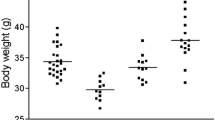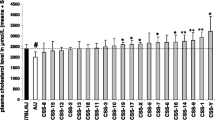Abstract
Baseline serum hematocrit varies substantially in the population. While additive genetic factors account for a large part of this variability, little is known about the genetic architecture underlying the trait. Because hematocrit levels vary with age, it is plausible that quantitative trait loci (QTL) that influence the phenotype also show an age-specific profile. To investigate this possibility, hematocrit was measured in three different age cohorts of mice (150, 450, and 750 days) of the C57BL/6J (B6) and the DBA2/J (D2) lineage. QTL were searched in the B6D2F2 intercross and the BXD recombinant inbred (RI) strains. The effects of these QTL were explored across the different age groups. On the phenotypic level, baseline serum hematocrit declines with age in a sex-specific manner. In the B6D2F2 intercross, suggestive QTL that influence the phenotype were located on Chromosomes (Chr) 1, 2, 7, 11, 13, and 16. With the exception of the QTL on Chr 2, all of these QTL exerted their largest effect at 750 days. The QTL on Chr 1, 2, 7, 11 and 16 were confirmed in the BXD RIs in a sex- and age-specific manner. Linkage analysis in the BXD RIs revealed an additional significant QTL on Chr 19. Baseline serum hematocrit is influenced by several QTL that appear to vary with the age and sex of the animal. These QTL primarily overlap with QTL that have been shown to regulate hematopoietic stem cell phenotypes.







Similar content being viewed by others
References
Broman KW, Wu H, Sen S, Churchill GA (2000) R/qtl: QTL mapping in experimental crosses. Bioinformatics 19:889–890
Bystrykh L, Weersing E, Dontje B, Sutton S, Pletcher MT, et al. (2005) Uncovering regulatory pathways that affect hematopoietic stem cell function using “genetical genomics”. Nat Genet 37:225–232
Churchill GA, Doerge RW (1994) Empirical threshold values for quantitative trait mapping. Genetics 138:963–971
deHaan G, Van Zant G (1999) Genetic analysis of hemopoietic cell cycling in mice suggests its involvement in organismal life span. FASEB J 13:707–713
deHaan G, Bystrykh LV, Weersing E, Dontje B, Geiger H, et al. (2002) A genetic and genomic analysis identifies a cluster of genes associated with hematopoietic cell turnover. Blood 100:2056–2062
Donelly S (2003) Why is erythropoietin made in the kidney? The kidney functions as a ‘critmeter’ to regulate hematocrit. Adv Exp Med Biol 543:73–87
Evans DM, Frazer IH, Martin NG (1999) Genetic and environmental causes of variation in basal levels of blood cells. Twin Res 2:250–257
Fujikawa K, Miletic AV, Alt FW, Faccio R, Brown T, et al. (2003) Vav1/2/3-null mice define an essential role for Vav family proteins in lymphocyte development and activation but a differential requirement in MAPK signaling in T and B cells. J Exp Med 198:1595–1608
Fulwood R, Johnson CL, Bryer JD, Gunter EW, McGrath CR (1980) Hematological and nutritional biochemistry reference data for persons 6 months-74 years of age: United States 1976–1980. Vital and Health Statistics Series 11-No.232, DHHS Publ. No. (PHS) 83-1682 (Washington, DC: Public Health Service)
Geiger J, True JM, deHaan G, Van Zant G (2001) Age-and stage-specific regulation patterns in the hematopoietic stem cell hierarchy. Blood 98:2966–2972
Heller DA, Ahern FM, Stout JT, McClearn GE (1998) Mortality and biomarkers of aging in heterogeneous stock (HS) mice. J Gerontol 53:B217–230
Henckaerts E, Geiger H, Langer CJ, Rebollo P, Van Zant G, et al. (2002a) Genetically determined variation in the number of phenotypically defined hematopoietic progenitor and stem cells and in their response to early acting cytokines. Blood 99:3947–3954
Henckaerts E, Langer JC, Snoeck H-W (2002b) Quantitative genetic variation in the hematopoietic stem cell and progenitor cell compartment and in lifespan are closely linked at multiple loci in BXD recombinant inbred mice. Blood 104:374–379
Henckaerts E, Langer JC, Orenstein J, Snoeck H-W (2004) The positive regulatory effect of TGT-β2 on primitive murine hematopoietic stem and progenitor cells is dependent on age, genetic background, and serum factors. J Immunol 173:2486–2493
Lander ES, Kruglyak L (1995) Genetic dissection of complex traits: Guidelines for interpreting and reporting linkage results. Nate Genet 11:241–247
Lander LS, Botstein D (1989) Mapping mendelian factors underlying quantitative traits using RFLP linkage maps. Genetics 121:185–199
Lionikas A, Blizard DA, Vandenbergh DJ, Glover MG, Stout JT, et al. (2003) Genetic architecture of fast- and slow-twitch skeletal muscle weight in 200-day-old mice of the C57BL/6J and DBA/2J lineage. Physiol Genomics 16:141–152
Mueller–Sieburg CE, Riblet R (1996) Genetic control of the frequency of hematopoietic stem cells in mice: Mapping of a candidate locus to chromosome 1. J Exp Med 183:1141–1150
Plomin R, McClearn GE (1993) Quantitative trait loci (QTL) analyses and alcohol-related behaviors. Behav Genet 126:277–284
Pravenec M, Zidek V, Zdobinska M, Kren V, Krenova D, et al. (1997) Mapping genes controlling hematocrit in the spontaneously hypertensive rat. Mamm Genome 8:387–389
R Development Core Team (2002) R: A language and environment for statistical computing (Vienna, Austria: R Foundation for Statistical Computing), ISBN 3-900051-07-0. Available at http://www.R-project.org
Russell ES, McFarland EC (1966) Analysis of pleiotropic effects of W and f genic substitutions in the mouse. Genetics 53:949–959
Schlager G, Weibust RS (1976) Selection for hematocrit percent in the house mouse. J Hered 67:295–299
Stino FKR, Washburn KW (1973) Divergent selection under two nutritional environments for packed erythrocyte volume in Japenese quail. Genetics 74:363–369
Strauss JA (1992) Physiological biomarkers of aging, using heterogeneous stock mice as a modeling system. PhD Dissertation, The Pennsylvannia State University
Van Hearingen WA, den Bieman MG, Lankhorst AE, van Lith HA, van Zutphen LFM (2002) Application of AFLP markers for QTL mapping in the rabbit. Genome 45:914–921
Van Zant G, Holland BP, Eldridge PW, Chen J-J (1990) Genotype-restricted growth and aging patterns in hematopoietic stem cell populations of allophonic mice. J Exp Med 171:1547–1565
Vandenbergh DJ, Heron K, Peterson R, Shpargel KB, Woodroofe A, et al. (2003) Simple tests to detect errors in high-throughput genotype data in the molecular laboratory. J Biomol Tech 14:9–16
Wang Q, Stacy T, Binder M, Marin–Padilla M, Sharpe AH, et al. (1996) Disruption of the Cbfa2 gene causes necrosis and hemorrhaging in the central nervous system and blocks definitive hematopoiesis. Proc Natl Acad Sci USA 93:3444–3449
Weibust RS, Schlager G (1968) A genetic study of blood pressure, hematocrit and plasma cholesterol in aged mice. Life Sci 7:1111–1119
Acknowledgments
This work was supported by the National Institute on Aging (grant AG14731) of the National Institutes of Health.
Author information
Authors and Affiliations
Corresponding author
Rights and permissions
About this article
Cite this article
Johannes, F., Blizard, D.A., Lionikas, A. et al. QTL influencing baseline hematocrit in the C57BL/6J and DBA/2J lineage: age-related effects. Mamm Genome 17, 689–699 (2006). https://doi.org/10.1007/s00335-006-0009-7
Received:
Accepted:
Published:
Issue Date:
DOI: https://doi.org/10.1007/s00335-006-0009-7




